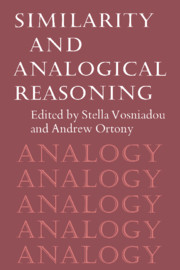Book contents
- Frontmatter
- Contents
- Preface
- List of contributors
- Similarity and analogical reasoning: a synthesis
- Part I Similarity and the structure of concepts
- Part II Analogical reasoning
- 7 The mechanisms of analogical learning
- 8 A computational model of analogical problem solving
- 9 Use of analogy in a production system architecture
- 10 Toward a microstructural account of human reasoning
- 11 Analogy and the exercise of creativity
- 12 Comments on Part II: Levels of description in information-processing theories of analogy
- 13 Comments on Part II: The role of explanation in analogy; or, The curse of an alluring name
- Part III Similarity and analogy in development, learning, and instruction
- Afterword: Comments on Parts I, II, and III: A framework for a theory of comparison and mapping
- Name index
- Subject index
8 - A computational model of analogical problem solving
Published online by Cambridge University Press: 22 October 2009
- Frontmatter
- Contents
- Preface
- List of contributors
- Similarity and analogical reasoning: a synthesis
- Part I Similarity and the structure of concepts
- Part II Analogical reasoning
- 7 The mechanisms of analogical learning
- 8 A computational model of analogical problem solving
- 9 Use of analogy in a production system architecture
- 10 Toward a microstructural account of human reasoning
- 11 Analogy and the exercise of creativity
- 12 Comments on Part II: Levels of description in information-processing theories of analogy
- 13 Comments on Part II: The role of explanation in analogy; or, The curse of an alluring name
- Part III Similarity and analogy in development, learning, and instruction
- Afterword: Comments on Parts I, II, and III: A framework for a theory of comparison and mapping
- Name index
- Subject index
Summary
The power of human intelligence depends on the growth of knowledge through experience, coupled with flexibility in accessing and exploiting prior knowledge to deal with novel situations. These global characteristics of intelligence must be reflected in theoretical models of the human cognitive system (Holland, Holyoak, Nisbett, & Thagard, 1986). The core of a cognitive architecture (i.e., a theory of the basic components of human cognition) consists of three subsystems: a problem-solving system, capable of drawing inferences to construct plans for attaining goals; a memory system, which can be searched in an efficient manner to identify information relevant to the current problem; and an inductive system, which generates new knowledge structures to be stored in memory so as to increase the subsequent effectiveness of the problem-solving system.
These three subsystems are, of course, highly interdependent; consequently, the best proving ground for theories of cognition will be the analysis of skills that reflect the interactions among problem solving, memory, and induction. One such skill is analogical problem solving – the use of a solution to a known source problem to develop a solution to a novel target problem. At the most general level, analogical problem solving involves three steps, each of which raises difficult theoretical problems (Holyoak, 1984, 1985). The first step involves accessing a plausibly useful analog in memory. It is particularly difficult to identify candidate analogs when they are concealed in a large memory system, and when the source and target were encountered in different contexts and have many salient dissimilarities. These theoretical issues are closely related to those raised in Schank's (1982) discussion of “reminding.”
- Type
- Chapter
- Information
- Similarity and Analogical Reasoning , pp. 242 - 266Publisher: Cambridge University PressPrint publication year: 1989
- 45
- Cited by



